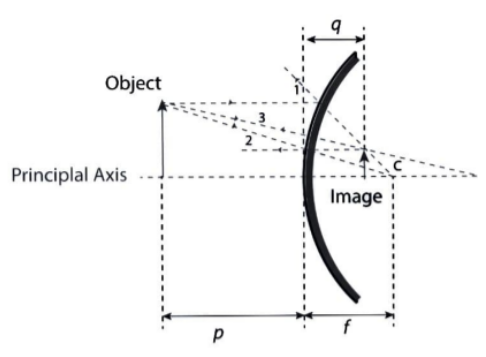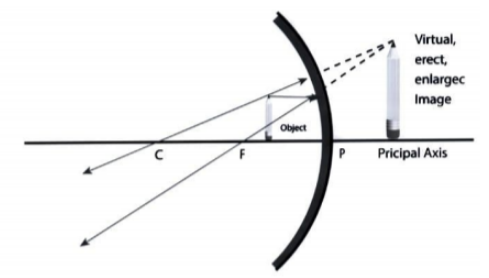
There are four mirrors labelled as I, II, III, and IV. Mirrors I and IV can form virtual and small images only. Mirror III can form an image that can be obtained on a screen. Mirror II cannot form real images of objects. Which of the given mirrors can form an inverted image of the object?
Answer
507k+ views
Hint: A mirror is a reflective surface that is smooth and highly polished. Plane mirrors are the most widely used mirrors. A part of a spherical reflection surface is a spherical mirror. Convex and concave mirrors are the two types of spherical mirrors.
Complete answer:
Convex Mirror: A convex mirror is a curved mirror with a reflecting surface that bulges outwards towards the light source. Since convex mirrors reflect light outwards, they cannot be used to concentrate light. The image is virtual, upright, and smaller than the object, but as the object approaches the mirror, it grows larger. Diverging mirrors are another name for these types of mirrors.

Concave Mirror: The reflective surface of a concave mirror caves inwards. Light is converged by concave mirrors to a single focal point. As a result, they're also known as converging mirrors. They're used to concentrate light. The size of the image created by a concave mirror varies depending on the object's location in relation to the mirror. Depending on the orientation of the object, the image may be actual or simulated, upright or reversed, magnified, reduced, or the same size as the object.

On a frame, the image created by mirror III can be seen. As a result, mirror III will produce a true image. This indicates that mirror III is concave. Mirror III can produce inverted images since only concave mirrors can produce true and inverted images of objects.
Note:The image formed by the concave mirror is determined by two parameters: the object distance and the focal length of the mirror. A magnified and erect virtual is created when an object is positioned between the pole and the focus of a concave mirror.
Complete answer:
Convex Mirror: A convex mirror is a curved mirror with a reflecting surface that bulges outwards towards the light source. Since convex mirrors reflect light outwards, they cannot be used to concentrate light. The image is virtual, upright, and smaller than the object, but as the object approaches the mirror, it grows larger. Diverging mirrors are another name for these types of mirrors.

Concave Mirror: The reflective surface of a concave mirror caves inwards. Light is converged by concave mirrors to a single focal point. As a result, they're also known as converging mirrors. They're used to concentrate light. The size of the image created by a concave mirror varies depending on the object's location in relation to the mirror. Depending on the orientation of the object, the image may be actual or simulated, upright or reversed, magnified, reduced, or the same size as the object.

On a frame, the image created by mirror III can be seen. As a result, mirror III will produce a true image. This indicates that mirror III is concave. Mirror III can produce inverted images since only concave mirrors can produce true and inverted images of objects.
Note:The image formed by the concave mirror is determined by two parameters: the object distance and the focal length of the mirror. A magnified and erect virtual is created when an object is positioned between the pole and the focus of a concave mirror.
Recently Updated Pages
Two men on either side of the cliff 90m height observe class 10 maths CBSE

What happens to glucose which enters nephron along class 10 biology CBSE

Cutting of the Chinese melon means A The business and class 10 social science CBSE

Write a dialogue with at least ten utterances between class 10 english CBSE

Show an aquatic food chain using the following organisms class 10 biology CBSE

A circle is inscribed in an equilateral triangle and class 10 maths CBSE

Trending doubts
The shortest day of the year in India

Why is there a time difference of about 5 hours between class 10 social science CBSE

Write a letter to the principal requesting him to grant class 10 english CBSE

What is the median of the first 10 natural numbers class 10 maths CBSE

The Equation xxx + 2 is Satisfied when x is Equal to Class 10 Maths

State and prove converse of BPT Basic Proportionality class 10 maths CBSE




